Electromagnetic Induction MCQs
NEET Physics For Electromagnetic Induction Multiple Choice Questions
Question 1. A square loop of side 1 m and resistance 1 \(\Omega\) is placed in a magnetic field of 0.5%T. If the plane of the loop is perpendicular to the direction of the magnetic field, the magnetic flux through the loop is:
- 2 weber
- 0.5 weber
- 1 weber
- Zero weber
Answer: 2. 1 weber
Given
A square loop of side 1 m and resistance 1 \(\Omega\) is placed in a magnetic field of 0.5%T. If the plane of the loop is perpendicular to the direction of the magnetic field,
Here, l=1 \(\mathrm{~m}, R=1 \Omega, \mathrm{B}=0.5 \mathrm{~T} \text {, }\)
Angle\(\theta=0^{\circ}\)
Magnetic flux,\(\phi=\mathrm{BA} \cos \theta \)
= 0.5 \(\times 1 \times 1 \times \cos 0^{\circ}\)
= 0.5 \(\mathrm{~Wb}\)
Question 2. A big circular coil of 1000 turns and an average radius of 10 m is rotating about its horizontal diameter at 2 rad s-1. If the vertical component of the earth’s magnetic field at that place is 2 x 10-5 T and the electrical resistance of the coil is 12.56 Ω, then the maximum induced current in the coil will be:
- 0.25 A
- 1.5 A
- 1A
- 2 A
Answer: 3. 1A
Given
A big circular coil of 1000 turns and an average radius of 10 m is rotating about its horizontal diameter at 2 rad s-1. If the vertical component of the earth’s magnetic field at that place is 2 x 10-5 T and the electrical resistance of the coil is 12.56 Ω
Here, the number of turns (N) =1000
Radius (r) =10 \(\mathrm{~m}\)
Magnetic field (B) =2 \(\times 10^{-5} \mathrm{~T}\)
Resistance(R) =12.56 \(\Omega \)
Maximum induced emf, \(\mathrm{E} =N \omega A B\)
= N \(\omega\left(\pi r^2\right) B\)
= 1000 \(\times 2 \times 3.14 \times(10)^2 \times 2 \times 10^{-5}\)
= 12.56 \(\mathrm{~V}\)
Maximum induced current, \(I_{\max }=\frac{E}{R}\)
= \(\frac{12.56}{12.56}=1 \mathrm{~A}\)
Electromagnetic Induction MCQs
Question 3. The magnetic flux linked with a coil (in Wb) is given by the equation \(\phi=5 t^2+3 t+16\). The magnitude of induced emf in the coil at the fourth second will be :
- 33 V
- 43 V
- 108 V
- 10 V
Answer: 4. 10 V
Given: Magnetic flux, \((\phi)=5 t^2+3 t+16\)
Induced emf, |E| =\(\frac{d \phi}{d t}\)
= \(\frac{d}{d t}\left(5 t^2+3 t+16\right)\)
= 10 t+3
Therefore induced emf, when t=3,
⇒ \(|E_3|=(10 \times 3)+3=33 \mathrm{~V}\)
and induced emf, when, t =4,
⇒ \(\left|E_4\right| =(10 \times 4)+3=43 \mathrm{~V}\)
Therefore emf induced in the fourth second
= \(|\varepsilon_4|-|\varepsilon_3|\)
= 43-33=10\( \mathrm{~V}\)
Read and Learn More NEET Physics MCQs
Question 4. A coil of 800 turns and an effective area of 0.05 m2 is kept perpendicular to a magnetic field 5 x 10-5 T. When the plane of the coil is rotated by 90° around any of its co-planner axis in 0.1 s. The emf induced in the coil will be :
- 0.2 V
- 2 x 10-3 V
- 0.02 V
- 2 V
Answer: 3. 0.02 V
Given
A coil of 800 turns and an effective area of 0.05 m2 is kept perpendicular to a magnetic field 5 x 10-5 T. When the plane of the coil is rotated by 90° around any of its co-planner axis in 0.1 s.
Here, N = 800 turn
A =0.05 \(\mathrm{~m}^2=5 \times 10^{-2} \mathrm{~m}^2\)
B =5 \(\times 10^5 \mathrm{~T}\)
⇒ \(\Delta t =0.15 \mathrm{sec}\)
We know that,
⇒ \(e_{\text {induced }} =-\frac{\Delta \phi}{\Delta t}\)
⇒ \(\Delta \phi =\phi_f-\phi_i \)
⇒ \(\phi_f=0, \phi_i =N(\vec{B} \cdot \vec{A})\)
= 800 \(\times 5 \times 10^{-5} \times 5 \times 10^{-2}\)
= 2 \(\times 10^{-3} \)
⇒ \(e_{\text {induced }} =-\frac{\Delta \phi}{\Delta t}=\frac{-\left(0-2 \times 10^{-3}\right)}{0.1}\)
=0.02 \(\mathrm{~V}\)
Electromagnetic Induction Questions For NEET
Question 5. A uniform magnetic field is restricted within a region of radius r. The magnetic field changes with time at a rate\(\frac{d B}{d t}\). Loop 1 of radius R > r encloses the region r and loop 2 of radius R is outside the region of the magnetic field as shown in the figure. Then, the emf generated is:
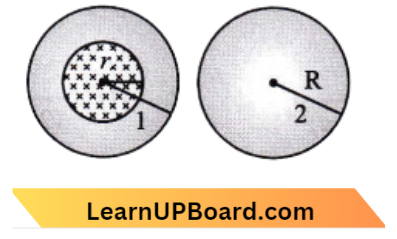
- zero in loop 1 and zero in loop 2
- –\(\frac{d B}{d t} \pi r^2 \)in loop 1 and\( -\frac{d B}{d t} \pi r^2\) in loop 2
- –\(\frac{d B}{d t} \pi \mathrm{R}^2\) in loop 1 and zero in loop 2
- –\(\frac{d B}{d} \pi r^2\) in loop 1 and zero in loop 2
Answer: 3. –\(\frac{d B}{d t} \pi \mathrm{R}^2\) in loop 1 and zero in loop 2
Given
A uniform magnetic field is restricted within a region of radius r. The magnetic field changes with time at a rate\(\frac{d B}{d t}\). Loop 1 of radius R > r encloses the region r and loop 2 of radius R is outside the region of the magnetic field as shown in the figure.
We know that induced emf in the region is given by
|e| =\(\frac{d \phi}{d t}\)
⇒ \(\frac{d \phi}{d t} =-\pi r^2 \frac{d B}{d t} \)
⇒ \({\phi=B A=\pi r^2 B e A=\pi r^2}\)
⇒ \(\frac{d \phi}{d t} =-\pi r^2 \frac{d B}{d t}\)
From the question, Rate of change of magnetic flux associated with loop (1)
⇒ \(e_1=-\frac{d \phi_1}{d t}=-\pi r^2 \frac{d B}{d t}\)
and Rate of change of magnetic flux associated with loop (2)
=\(-\frac{d \phi_2}{d t}\)=0 { since } \({\phi_2=0}\)
Question 6. A thin semicircular conducting ring (PQR) of radius V is falling vertically with its plane in a horizontal magnetic field B, as shown in the figure. The potential difference developed across the ring when its speed is v is:
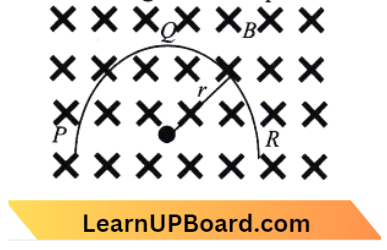
- Zero
- Bvπ² and P is at higher potential
- πrBv and R is at higher potential
- 2rBr and R is at higher potential.
Answer: 4. 2rBr and R is at higher potential.
Given
A thin semicircular conducting ring (PQR) of radius V is falling with its plane vertically in a horizontal magnetic field B, as shown in the figure.
Rate of decrease of area of semicircular ring = \(\frac{d A}{d t}=(2 r) \mathrm{V}\)
From Faraday’s law of electromagnetic induction = e=\(-\frac{d \phi}{d t}=-B \frac{d A}{d t}=-B(2 r \mathrm{~V})\)
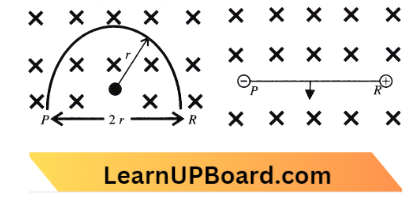
As induced current in the ring produces a magnetic field in an upward direction hence R is at higher potential.
Electromagnetic Induction Questions For NEET
Question 7. A wire loop is rotated in a magnetic field. The frequency of change of direction of the induced e.m.f is:
- twice per revolution
- four times per revolution
- six times per revolution
- once per revolution.
Answer: 1. twice per revolution
This is the case of periodic EMI.
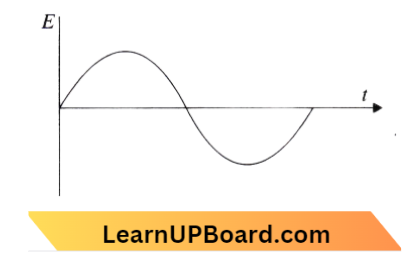
From the graph, it is clear that direction is changing once in \(\frac{1}{2}\) cycle.
Question 8. A coil of resistance 400 \(\Omega\) is placed in a magnetic field. If the magnetic flux \(\phi\)(Wb) linked with the coil varies with time t (sec) as \(\phi=50 t^2+4\). The current in the coil at t = 2 s is:
- 0.5 A
- 0.1A
- 2 A
- 1 A
Answer: 1. 0.5 A
Given
A coil of resistance 400 \(\Omega\) is placed in a magnetic field. If the magnetic flux \(\phi\)(Wb) linked with the coil varies with time t (sec) as \(\phi=50 t^2+4\).
We know that, Induced emf of coil,
E= \(|-\frac{d \phi}{d t}|_t\)
Given that, \(\phi=50 t^2+4\) and R=400 \(\Omega\)
E = \(|\frac{-d \phi}{d t}|_{t=2}[100 t]_{t=2}\)
= 200 \(\mathrm{~V}\)
Current in the coil I=\(\frac{E}{R}=\frac{200}{400}\)
=0.5 \(\mathrm{~A} \text {. }\)
Electromagnetic Induction Questions For NEET
Question 9. A conducting circular loop is placed in a uniform magnetic field. B = 0.025 T with its plane perpendicular to the loop. The radius of the loop is made to shrink at a constant rate of 1 mms-1. The induced emf when the radius is 2 cm, is:
- 2 \(\pi \mu V\)
- \(\pi \mu \mathrm{V}\)
- \(\frac{\mu}{2} \mu \mathrm{V}\)
- 2 \(\mu \mathrm{V}\)
Answer: 2. \(\pi \mu \mathrm{V}\)
Given
A conducting circular loop is placed in a uniform magnetic field. B = 0.025 T with its plane perpendicular to the loop. The radius of the loop is made to shrink at a constant rate of 1 mms-1.
We know that, \(\phi=B A\)
⇒ \(E_{\text {in }} =\frac{-d \phi}{d t} \)
⇒ \(E_{\text {in }} =-\frac{d}{d t}(B A)\)
⇒ \(E_{\text {ir }} =-B \pi 2 r \frac{d r}{d t} \)
E =-B \(\pi 2 r \frac{d r}{d t} \)
-0.025 \(\times \pi \times 2 \times 2 \times 10^{-1} \times 10^{-3}\)
Compare with original formula, induced emf =\(\pi \mu \mathrm{V}\)
NEET Physics MCQs
Question 10. A conducting circular loop is placed in a uniform magnetic field of 0.04 T with its plane perpendicular to the magnetic field. The radius of the loop starts shrinking at 2 mms-1. The induced emf in the loop, when the radius is 2 cm, is:
- \(3.2 \pi \mu \mathrm{V}\)
- 4.8 \(\pi \mu \mathrm{V}\)
- 0.8 \(\pi \mu \mathrm{V}\)
- 1.6 \(\pi \mu \mathrm{V}\)
Answer: 1. \(3.2 \pi \mu \mathrm{V}\)
According to the question,
A conducting circular loop is placed in a uniform magnetic field of 0.04 T with its plane perpendicular to the magnetic field. The radius of the loop starts shrinking at 2 mms-1.
Magnetic field, B=0.04 \(\mathrm{~T}\)
and \(-\frac{d r}{d t}=2 \mathrm{~ms}^{-1}\)
Induced emf is equal to the rate of change of magnetic flux linked with the circuit
Induced emf, e =\(-\frac{d \phi}{d t}\)
=-\(\frac{B d A}{d t}=-B \frac{d\left(\pi r^2\right)}{d t}\)
If r=2 \(\mathrm{~cm}\) then,
e =-0.04 \(\times \pi \times 2 \times 2 \times 10^{-2} \times 2 \times 10^{-3} \)
=3.2 \(\pi \mu \mathrm{V}\)
Question 11. A beam of electrons passes undeflected through mutually perpendicular electric and magnetic fields. If the electric field is switched off, and the same magnetic field is maintained, the electrons move:
- in a circular orbit
- along a parabolic path
- along a straight line
- in an elliptical orbit.
Answer: 1. in a circular orbit
In the magnetic field a charged particle moves in a circular orbit.
NEET Physics MCQs
Question 12. As a result of a change in the magnetic flux linked to the closed loop as shown in the figure, an e.m.f V volt is induced in the loop. The work done (joules) in taking a charge Q coulomb once along the loop is:

- QV
- 2 QV
- \(\frac{Q V}{2}\)
- zero
Answer: 1. QV
Work done due to a charge W= QV
NEET Physics MCQs
Question 13. A rectangular coil of 20 turns and an area of cross-section of 25 sq cm has a resistance of 100 fl If a magnetic field that is perpendicular to the plane of the coil changes at a rate of 1000 T/s, the current in the coil is:
- 1A
- 50 A
- 0.5 A
- 5 A
Answer: 3. 0.5 A
Given
A rectangular coil of 20 turns and an area of cross-section of 25 sq cm has a resistance of 100 fl If a magnetic field that is perpendicular to the plane of the coil changes at a rate of 1000 T/s
Total number of turns, N=20
Area of coil, A =25 \(\mathrm{~cm}^2 \)
=25 \(\times 10^{-4} \mathrm{~m}^2\)
Change in magnetic field w.r.t. $t
⇒ \(\frac{d B}{d t}=1000 \mathrm{~T} / \mathrm{s}\)
Resistance of coil, R=100 \(\Omega\)
i = ?
We have, Induced current, i=\(\frac{e}{R}\)
= \(\frac{N A \frac{d B}{d t}}{R} \cdot[e=N A \frac{d B}{d t}]\)
= \(\frac{20 \times 25 \times 10^{-4} \times 1000}{100}\)
= 0.5 \(\mathrm{~A}\)
Question 14. An electron moves on a straight line path XY as shown. The abcd is a coil adjacent to the path of the electron. What will be the direction of current, If any induced in the coil?
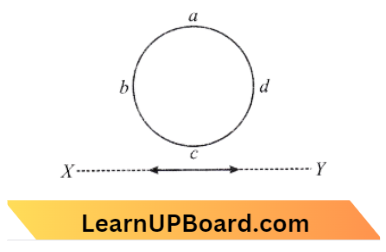
- abcd
- adcb
- The current will reverse its direction as the electron goes past the coil
- No current induced.
Answer: 3. The current will reverse its direction as the electron goes past the coil
When the electron goes in a straight line electric flux first increases and then decreases.
Class 12 Electromagnetic Induction MCQs
Question 15. A conductor of length 0.4 m is moving with a speed of 7 m/s perpendicular to a magnetic field of intensity 0.9 Wb/m². The induced emf across the conductor is:
- 1.26 V
- 2.52 V
- 5.04 V
- 25.2 V
Answer: 2. 2.52 V
Given, length of conductor (l)=0.4 \(\mathrm{~m}\),
speed \((v)=7 \mathrm{~m} / \mathrm{s}\)
Magnetic field (B)=0.9 \(\mathrm{~Wb} / \mathrm{m}^2\)
Induced emf, e=B I v \(\sin \theta\)
⇒ \([\theta=90^{\circ}.\) as B is perpendicular to V
=0.9 \(\times 0.4 \times 7 \times \sin 90^{\circ}\)
=2.52 \(\mathrm{~V}\)
Question 16. In the circuit of Fig, the bulb will become suddenly bright if
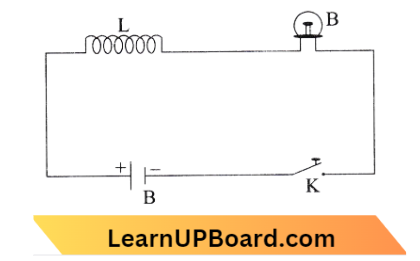
- contact is made or broken
- contact is made
- contact is broken
- won’t become bright at all.
Answer: 3. contact is broken
When a circuit is broken, the induced e.m.f. is largest. So the answer is (C).
Question 17. A wheel with 20 metallic spokes, each 1 m long, is rotated with a speed of 120 rpm in a plane perpendicular to a magnetic field of 0.4 G. The induced emf between the axle and rim of the wheel will be (1 G = \(10^{-4}\) T):
- 2.51 \(\times 10^{-4} \mathrm{~V}\)
- 2.51 \(\times 10^{-5} \mathrm{~V}\)
- 40 \(\times 10^{-5} \mathrm{~V}\)
- 2.51 \(\mathrm{~V}\)
Answer: 1. 2.51 \(\times 10^{-4} \mathrm{~V}\)
In the question, B =0.4 \(\mathrm{G}=0.4 \times 10^{-4} \mathrm{~T}\)
l =1 \(\mathrm{~m} \)
f =120 \(\mathrm{rpm}=\frac{120}{60} \mathrm{rps}=2 \mathrm{~Hz}\)
Induced emf between the axle and rim of the wheel is:
e =\(\frac{1}{2} B \omega l^2 \)
= \(\frac{1}{2} B(2 \pi f) l^2=\pi B f l^2 \)
= 3.14 \(\times 0.4 \times 10^{-4} \times 2 \times 1\)
= 2.51 \(\times 10^{-4} \mathrm{~V}\) .
Class 12 Electromagnetic Induction MCQs
Question 18. A cycle wheel of radius 0.5 m is rotated with a constant angular velocity of 10 rad/s in a region of the magnetic field of 0.1 T which is perpendicular to the plane of the wheel. The EMF generated between its center and the rim is :
- 0.25 V
- 0.125 V
- 0.5 V
- zero
Answer: 2. 0.125 V
According to the question

e =\(\frac{B I^2 \omega}{2} \)
= \(\frac{1}{2} \times 0.1 \times\left(\frac{1}{2}\right)^2 \times 10=\frac{1}{8} \)
= 0.125 \(\mathrm{~V}\)
NEET Electromagnetic Induction Questions
Question 19. A conducting square frame of length ‘a’ and a long straight wire carrying current / are located in the same plane as shown in the figure. The frame moves to the right with a constant velocity of V. The emf induced in the frame will be proportional to:
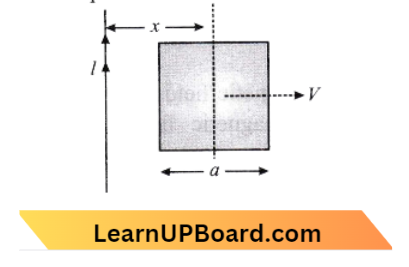
- \(\frac{1}{x^2}\)
- \(\frac{1}{(2 x-a)^2}\)
- \(\frac{1}{(2 x+a)^2}\)
- \(\frac{1}{(2 x-a)(2 x+a)}\)
Answer: 4. \(\frac{1}{(2 x-a)(2 x+a)}\)
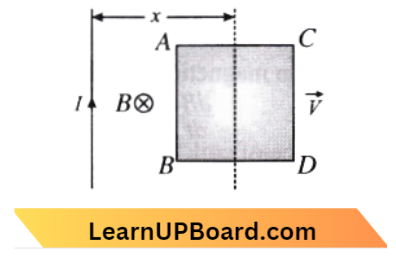
Potential difference across \(\mathrm{AB}\) is,
⇒ \(V_A-V_B=e_1=B_1(a) v\)
Where, \(B_1\)= magnetic field induction at A B
But, \(B_1=\frac{\mu_0}{4 \pi} \frac{2 i}{\left(x-\frac{a}{2}\right)}\)
Putting the value of B_1 in eq. (1),
⇒ \(e_1=\frac{\mu_0 i}{2 \pi\left(x-\frac{a}{2}\right)} a v\)
Potential difference \(\mathrm{CD}\) is given by
⇒ \(V_C-V_D=e_2=B_2(a) v\)
But, \(\mathrm{B}_2=\frac{\mu_0}{4 \pi} \cdot \frac{2 i}{\left(x+\frac{a}{2}\right)}\)
⇒ \(e_2=\frac{\mu_0 i}{2 \pi\left(x+\frac{a}{2}\right)} a v\)
The net potential difference in the loop \(\mu\)
⇒ \(e_1-e_2 =\left(V_A-V_B\right)-\left(V_C-V_D\right) \)
= \(\frac{\mu_0 i^{\prime} a v}{2 \pi}\left(\frac{1}{x-\frac{a}{2}}-\frac{1}{x+\frac{a}{2}}\right) \)
= \(\frac{\mu_0 i^{\prime} a v}{2 \pi}\left(\frac{2 a}{\left(x-\frac{a}{2}\right)\left(x+\frac{a}{2}\right)}\right)\)
Hence clear that it is Proportional to \(\frac{1}{(2 x-a)(2 x+a)}\)
NEET Electromagnetic Induction Questions
Question 20. In coil of resistance 10 \(\Omega\) the induced current developed by changing magnetic flux through it is shown in the figure as a function of time. The magnitude of change in flux through the coil in Weber is:
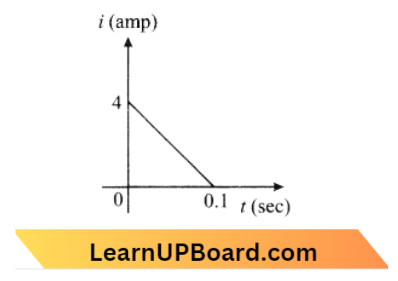
- 8
- 2
- 6
- 4
Answer: 2. 2
Here, I=\(\left|\frac{1}{R} \frac{d \phi}{d t}\right|\)
⇒ \(|d \phi|=|I R d t| \)
⇒ \(d \phi=(\text { Area of triangle }) \times R\)
=\(\left(\frac{1}{2} \times 4 \times 0.1\right) \times 10=2 \mathrm{~Wb}\)
Question 21. The magnetic flux through a circuit of resistance R changes by an amount \(\Delta \phi\) in a time \(\Delta t\). Then the total quantity of electric charge Q that passes any point in the circuit during the time \(\Delta t\) is represented by:
- Q=\(\frac{1}{R} \cdot \frac{\Delta \phi}{\Delta t}\)
- Q=\(\frac{\Delta \phi}{R}\)
- Q=\(\frac{\Delta \phi}{\Delta t}\)
- Q=R \(\cdot \frac{\Delta \phi}{\Delta t}\)
Answer: 2. Q=\(\frac{\Delta \phi}{R}\)
According to the question on induced emf is:
V =\(\frac{\Delta \phi}{\Delta \lambda}\)
and current, I =\(\frac{Q}{\Delta t}=\frac{\Delta \phi}{\Delta t} \times \frac{1}{R} \)
Q =\(\frac{\Delta \phi}{R}\)
NEET Electromagnetic Induction Questions
Question 22. In which of the following devices, the eddy current effect is not used?
- Magnetic braking in train
- Electromagnet
- Electric heater
- Induction furnace
Answer: 3. Electric heater
Eddy currents are loops of electrical current induced within a conductor by a changing magnetic field in the conductor according to Faraday’s law of induction. Eddy currents flow in closed loops within conductors, in planes perpendicular to the magnetic field. Electric heaters are not based on the eddy current effect. It is based on Joule’s heating effect
Question 23. Two conducting circular loops of radii \(R_1\) And \(R_2\) are placed in the same plane with their centers coinciding. If \(R_1 \gg R_2\), the mutual inductance between them will be directly proportional to:
- \(\frac{R_1}{R_2}\)
- \(\frac{R_2}{R_1}\)
- \(\frac{R_1^2}{R_2}\)
- \(\frac{R_2^2}{R_1}\)
Answer: 3.\(\frac{R_1^2}{R_2}\)
Given, Radii of loops, \(R_1\) and \(R_2\),
⇒ \(R_1 >>R_2 \)
M =?
we know, \(M_{12}=\frac{\mu_0 N_1 N_2 \pi R_1^2}{l}\)
⇒ \(M_{21}=\frac{\mu_0 N_1 N_2 \pi R_2^2}{l}\)
∴ \(\frac{M_1}{M_2}=\frac{R_1^2}{R_2^2}\)
NEET Electromagnetic Induction Questions
Question 24. The variation of EMF with time for four types of generators is shown in the figures. Which amongst them can be called AC?
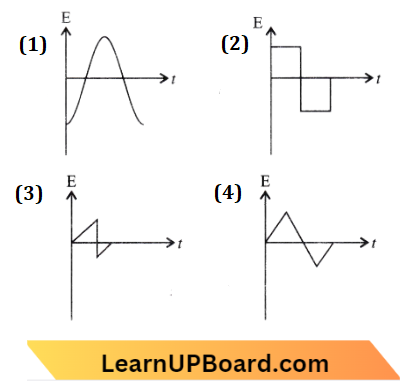
- Only (1)
- (1) and (4)
- (1), (2), (3) and (4)
- (1) and (2)
Answer: 3. (1), (2), (3) and (4)
A current that changes its direction periodically is called an alternating current
Question 25. The magnetic potential energy stored in a certain inductor is 25 ml, when the current in the inductor is 60 mA. This inductor is of inductance:
- 1.389 H
- 138.88 H
- 0.138 H
- 13.89 H
Answer: 4. 13.89 H
Given, U=25 \(\mathrm{~mJ} =25 \times 10^{-3} \mathrm{~J}\)
I =60 \(\mathrm{~mA}=60 \times 10^{-3} \mathrm{~A}\)
Energy stored in inductor, E=\(\frac{1}{2} L \times I^2\)
⇒ \(25 \times 10^{-3} =\frac{1}{2} L \times(60 \times(-3))^2\)
L =\(\frac{25 \times 2 \times 10^6 \times 10^{-3}}{3600}=\frac{500}{36} \)
=13.89 Henry
Important Electromagnetic Induction MCQs
Question 26. A long solenoid has 1000 turns. When a current 4 A flows through it, the magnetic flux linked with each turn of the solenoid “is 4 x 10-5 Wb. The self-inductance of the solenoid is:
- 3 H
- 2 H
- 1 H
- 4 H
Answer: 3. 1 H
From the question,
Number of turns of the solenoid, \(\mathrm{N}\)=1000
Current, I=4 \(\mathrm{~A}\)
And magnetic flux,\( \phi=4 \times 10^{-3} \mathrm{~Wb}\)
self induction, L =\(\frac{\phi . N}{I}\)
= \(\frac{4 \times 10^{-3} \times 1000}{4}=1 \mathrm{H}\)
Question 27. A current of 2.5 A flows through a coil of inductance 5 H. The magnetic flux linked with the coil is.
- 2 Wb
- 0.5 Wb
- 12.5 Wb
- Zero
Answer: 3. 12.5 Wb
Given: Current I =2.5
Inductance, L = 5H
Magnetic flux, \(\phi\)=?
We know, \(\phi\) =L I
=5 \(\times 2.5 \mathrm{~Wb}=12.5 \mathrm{~Wb}\)
Question 28. The current (I) in the inductance is varying with time according to the plot shown in the figure.
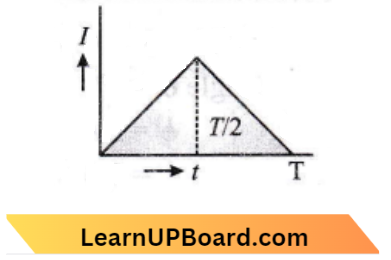
Which one of the following is the correct variation of voltage with time in the coil?
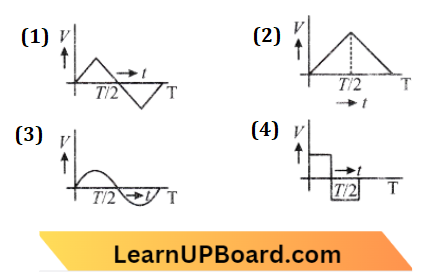
Answer: 4.
From the diagram, for t=0 to t=T / 2. induced voltage
V =L \(\frac{d I}{d t}\)
= L \(\frac{d}{d t}\left(\frac{2 I_0 t}{T}\right)\)= constant
For t=\(\frac{T}{2}\) to t=T induced
V =L \(\frac{d I}{d t}\)
=L \(\frac{\mathrm{d}}{d t}\left(\frac{-2 I_0 t}{T}\right)\)=- constant
This confirms that option (D) is correct.
Important Electromagnetic Induction MCQs
Question 29. The current i in a coil varies with time as shown in the figure. The variation induced emf with time would be
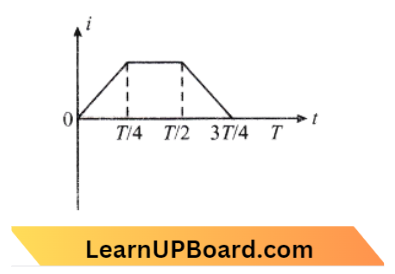
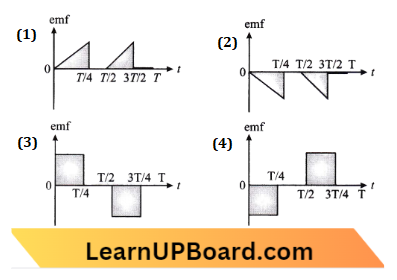
Answer: 4.
We know that, e=-L \(\frac{d I}{d t}\)
During 0 to \(\frac{T}{4}, \frac{d I}{d t}\)= constant
e=\(-V_0\)
For \(T_4\) to\( T_2\), \(\frac{d I}{d t}\)=0
e=0
For \(\frac{T}{2} to \frac{3 T}{4}, \frac{d I}{d t}\)= constant
e=+ve
Important Electromagnetic Induction MCQs
Question 30. Two coils of self-inductance 2 mH and 8 mH are placed so close together that the effective flux in one coil is completely linked with the other. The mutual inductance between these coils is:
- 16 mH
- 10 mH
- 6 mH
- 4 mH
Answer: 4. 4 mH
Given
Two coils of self-inductance 2 mH and 8 mH are placed so close together that the effective flux in one coil is completely linked with the other.
Mutual inductance between coils is,
M =k \(\sqrt{I_1 I_2}\)
M =1 \(\sqrt{2 \times 10^{-3} \times 8 \times 10^{-3}} \) {x=1}
= 4 \(\times 10^{-3}=4 \mathrm{mH} \)
Question 31. In an inductor of self-inductance L = 2 mH, current changes with time according to relation i = At what time emf ‘xs zero?
- 4s
- 3s
- 2s
- 1s
Answer: 3. 2s
L=2 \(\mathrm{mH}, i=i^2 e^{-t}\)
E=-L \(\frac{d i}{d t}=-L\left[-t^2 e^{-t}+2 t e^{-t}\right]\)
when, E=0,
⇒ \(-e^{-t} t^2+2 t e^{-1}\)=0
i.e. \(t e^{-t}(t-2)\)=0
t \(\neq \infty\) and t \(\neq 0\)
-t \(\neq 2 \mathrm{sec} (t e^{-t}=0\)
or, \(2 t e^{-t}=e^{-1} t^2 \)
t=2 \(\mathrm{sec} \)
NEET Physics Chapter-Wise MCQs
Question 32. A varying current in a coil changes from 10 A to zero in 0.5 s. If the average emf induced in the coil is 220 V, the self-inductance of the coil is:
- 5 H
- 6 H
- 11 H
- 12 H.
Answer: 3. 11 H
Emf induced in the coil of self-inductance, L
e=-L \(\frac{d \phi}{d t}=-\frac{d}{d t}(L i) \text { or } e=-L \frac{d i}{d t}\)
⇒ \((\frac{d i}{d t}\)= rate of flow of current in coil
As, d i\(=i_2-i_1=0-10=-10 \mathrm{~A} \)
d t=0.5 \(\mathrm{~s}\)
e=220 \(\mathrm{~V} \)
220=-L \(\frac{(-10)}{0.5}\)
or , L=\(\frac{220}{20}=11 \mathrm{H} \)
Question 33. What is the self-inductance of a coil that produces 5 V when the current changes from 3 A to 2 A in one millisecond?
- 5000 H
- 5 mH
- 50 H
- 5 H
Answer: 2. 5 mH
Emf induced in the coil is given by,
e=-\(\frac{d \phi}{d t}\)
If the coil has self-inductance (L) and current i, then induced emf is given by
e =-\(\frac{d}{d t}(\mathrm{Li}) or \mathrm{e}=-\mathrm{L} \frac{d i}{d t} \)
⇒ \(\mathrm{L} =\frac{\frac{|e|}{d i}}{d t}\)
Given, e \(\mid =5 \mathrm{~V}, d i=3-2=1 \mathrm{~A} \)
d t =1 \(\mathrm{~ms}=1 \times 10^{-3} \mathrm{~s} \)
∴ \(\mathrm{~L} =\frac{5 \times 10^{-3}}{1}=5 \mathrm{mH}\)
NEET Physics Chapter-Wise MCQs
Question 34. If the number of turns per unit length of a coil of solenoid is doubled, the self-inductance of the solenoid will:
- remain unchanged
- halved
- be doubled
- become four times
Answer: 4. become four times
A long solenoid is one whose length is significantly greater than its cross-section radius. If N is the total number of turns in the solenoid, A is the area of each turn, and 1 is the length of the solenoid, then the self-inductance of the solenoid is L=\(\frac{\mu_0 N^2 A}{I} \Rightarrow L=\mu_0 n^2 A I\)
L=\(\frac{\mu_0 N^2 A}{I} \Rightarrow L=\mu_0 n^2 A I\)
(If the number of turns per unit length is \(\mathrm{n}.)\)
So,\(\mathrm{L} \alpha \mathrm{n}^2\)
When \(n^2\) is doubled, L becomes 4 times.
NEET Physics Chapter-Wise MCQs
Question 35. A wire loop is rotated in a magnetic field. The frequency of change of direction of the induced emf is:
- once per revolution
- twice per revolution
- four times per revolution
- six times per revolution
Answer: 2. twice per revolution
The flux of the magnetic field through the 100 \(\pi\) is,
⇒ \(\phi=B \pi r^2 \cos \omega t\)
where \(\theta\)= angle the normal makes with the portion of the 100 \(\pi\) induced emf
⇒ \(\varepsilon=\omega B \pi r^2 \sin \omega t\)
These is zero when \(\omega t=n \pi\) i.e.,
when, \(\theta=0, \pi, 2 \pi \ldots\). etc.,
So, the induced emf changes direction every half rotation.
